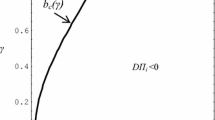Abstract
In a model of a duopolistic product market with a unionized labor force, this paper explores the interaction between firms' duopolistic behavior and union-firm bargaining. In a two-union/two-firm setting, we show that adopting efficient bargaining can improve a firm's competitiveness as well as efficiency, and it arises in equilibrium; while in a one-union/two-firm set-up, we find that an industry union prefers wage bargaining. However, when foreign competition in the product market intensifies, even the industry union prefers efficient bargaining. As an application, the analysis may explain differences in international competitiveness and the recent trend toward labor-management cooperation in the labor market.
Similar content being viewed by others
References
Anderson, S., and Devereux, M. (1989): “Profit-sharing and Optimal Labour Contracts.”Canadian Journal of Economics 22: 425–433.
Bean, C., and Turnbull, P. (1988): “Employment in the British Coal Industry: a Test of the Labour Demand Model.”Economic Journal 98: 1092–1104.
Brander, J. A., and Spencer, B. J. (1985): “Export Subsidies and International Market Share Rivalry.”Journal of International Economics 18: 83–100.
— (1988): “Unionized Oligopoly and International Trade Policy.”Journal of International Economics 24: 217–234.
Bulow, J. I., Geanakoplos, J. D., and Klemperer, P. D. (1985): “Multimarket Oligopoly: Strategic Substitutes and Complements.”Journal of Political Economy 93: 488–511.
Davidson, C. (1988): “Multiunit Bargaining in Oligopolistic Industries.”Journal of Labor Economics 6: 397–422.
Dobson, P. W. (1994): “Multifirm Unions and the Incentive to Adopt Pattern Bargaining in Oligopoly.”European Economic Review 38: 87–100.
Dowrick, S. (1989): “Union-Oligopoly Bargaining.”Economic Journal 99: 1123–1142.
Dunlop, J. T. (1944):Wage Determination Under Trade Unions. New York: Macmillan.
Espinosa, M. P., and Rhee, C. (1989): “Efficient Wage Bargaining as a Repeated Game.”Quarterly Journal of Economics 104: 565–588.
Feenstra, R. C. (1989):Trade Policies for International Competitiveness. Chicago. University of Chicago Press.
Fershtman, C., and Judd, K. L. (1987): “Equilibrium Incentives in Oligopoly.”American Economic Review 77: 927–940.
Goto, J. (1990):Labour in International Trade Theory. Baltimore: Johns Hopkins University Press.
Grossman, G. M. (Ed.) (1991):Imperfect Competition and International Trade. Cambridge, MA: MIT Press.
Hoel, M. (1991): “Union Wage Policy: the Importance of Labour Mobility and the Degree of Centralization.”Economica 58: 139–153.
Johnson, G. E. (1990): “Work Rules, Featherbedding, and Pareto-optimal Union-Management Bargaining.”Journal of Labor Economics 8: S236-S259.
Krugman, P.R. (1984): “Import Protection as Export Promotion: International Competition in the Presence of Oligopoly and Economies of Scale.” InMonopolistic Competition and International Trade, edited by H. Kerrzkowski. Oxford: Oxford University Press.
McCurdy, T., and Pencavel, J. (1986): “Testing Between Competing Models of Wage and Employment Determination in Unionized Market.”Journal of Political Economy [Supplement] 94: S3-S39.
McDonald, I. M., and Solow, R. M. (1981): “Wage Bargaining and Employment.”American Economic Review 71: 896–908.
Mezzetti, C., and Dinopoulos, E. (1991): “Domestic Unionization and Import Competition.”Journal of International Economics 31: 79–100.
Nickell, S. J. (1982): “A Bargaining Model of the Philips Curve.” London School of Economics, Centre for Labour Economics Discussion Paper.
Oswald, A. J. (1985): “The Economic Theory of Trade Union: an Introductory Survey.”Scandinavian Journal of Economics 87: 160–193.
— (1993): “Efficient Contracts Are on the Labour Demand Curve: Theory and Facts.”Labour Economics 1: 85–113.
Pencavel, J. (1985): “Wages and Employment Under Trade Unionism: Microeconomic Models and Macroeconomic Applications.”Scandinavian Journal of Economics 87: 197–225.
Pemberton, J. (1988): “A ‘Managerial’ Model of the Trade Union.”Economic Journal 98: 755–771.
Sklivas, S. D. (1987): “The Strategic Choice of Managerial Incentives.”Rand Journal of Economics 18: 452–458.
Svejnar, J. (1986): “Bargaining Power, Fear of Disagreement and Wage Settlements: Theory and Evidence from U.S. Industry.”Econometrica 54: 1055–1078.
Vickers, J. (1985): “Delegation and the Theory of the Firm.”Economic Journal [Supplement] 95: 138–147.
Author information
Authors and Affiliations
Rights and permissions
About this article
Cite this article
Yang, B.Z. Unionized oligopoly, labor-management cooperation, and international competitiveness. Zeitschr. f. Nationalökonomie 62, 33–53 (1995). https://doi.org/10.1007/BF01227537
Received:
Revised:
Issue Date:
DOI: https://doi.org/10.1007/BF01227537




